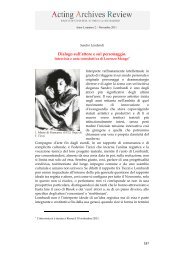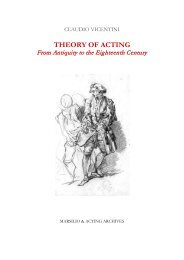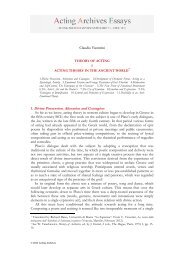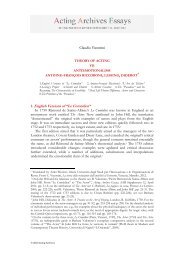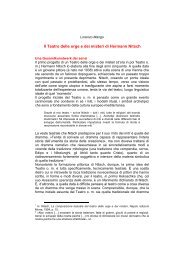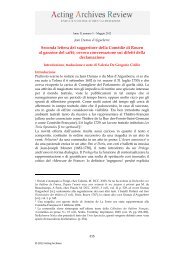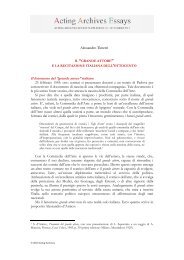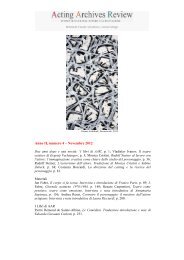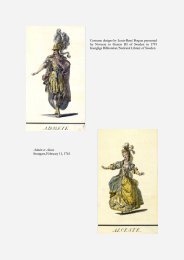Maria Ines Aliverti_The Miniatures of Jean Louis ... - Acting Archives
Maria Ines Aliverti_The Miniatures of Jean Louis ... - Acting Archives
Maria Ines Aliverti_The Miniatures of Jean Louis ... - Acting Archives
You also want an ePaper? Increase the reach of your titles
YUMPU automatically turns print PDFs into web optimized ePapers that Google loves.
AAR <strong>Acting</strong> <strong>Archives</strong> Essays Supplement 10 – April 2011<br />
the publication in Paris <strong>of</strong> the four volumes <strong>of</strong> the Nouvelles récréations physiques et<br />
mathématiques by Monsieur Guyot <strong>of</strong> the Société littéraire et militaire <strong>of</strong> Besançon, the<br />
second volume <strong>of</strong> which was entirely devoted to optical recreations and gave<br />
instructions both on the instruments and on how to produce and paint<br />
transparencies. 72<br />
In drawing-rooms, too, show-boxes used for viewing drawings and engravings<br />
were extremely popular. <strong>The</strong>atrical views were composed <strong>of</strong> perspective sets with or<br />
without characters. <strong>The</strong> transparencies were mounted in the show-box: thanks to the<br />
optical device the whole scene was visible with a depth <strong>of</strong> field that enhanced its<br />
realism. <strong>The</strong> taste for theatrical vues d’optique thus created a way <strong>of</strong> looking at the<br />
scene and the actors that was imaginary, iconic and removed from the material<br />
conditions <strong>of</strong> performance. We must therefore take account <strong>of</strong> this cultural context,<br />
which saw reproduction play a growing role in the diffusion <strong>of</strong> visual spectacle, in<br />
order to grasp fully the significance <strong>of</strong> Faesch’s miniatures.<br />
Faesch’s miniatures, probably painted using a camera obscura, were also destined<br />
to be viewed in a show-box. 73 <strong>The</strong> vellum used by Faesch as support for drawing,<br />
sometimes oiled to secure its transparency, the density <strong>of</strong> the pigments, and the<br />
outlines marked in Chinese ink to highlight the pattern <strong>of</strong> colours, suggest that these<br />
gouaches, or at least many <strong>of</strong> them, were born as enluminures d’optique, for which<br />
special paint mixtures were selected. 74<br />
However, in order to reach well-founded hypotheses on Faesch’s procedure and<br />
his possible use <strong>of</strong> optical instruments, we must ask whether he had foreseen right<br />
from the beginning, that is from 1765, the possibility <strong>of</strong> producing multiple copies <strong>of</strong><br />
the same vignette, something which does not seem unlikely, at least within certain<br />
limits. It seems improbable, in fact, that the actors who agreed to be portrayed would<br />
not have wanted a copy <strong>of</strong> the miniatures for themselves. We know that Lekain<br />
possessed some, and the same is undoubtedly true <strong>of</strong> the others. However, it does<br />
not necessarily follow that the idea <strong>of</strong> “serial” production, or <strong>of</strong> having the vignettes<br />
engraved, came right at the beginning. It is no coincidence, in fact, that they were<br />
actually engraved several years later: the first edition <strong>of</strong> Les Métamorphoses was<br />
published at the end <strong>of</strong> 1769, several years after Garrick’s stay in Paris, which, as we<br />
portative’ on p. 63. This portable camera was told to be <strong>of</strong> a great usefulness for amateur artists who<br />
intended to draw from life with right proportions and precision <strong>of</strong> details: ‘Par le moyen de cet<br />
instrument, […] quelqu’un qui ne sait pas le dessein pourra néanmoins dessiner les objets avec la<br />
dernière justesse et la dernière exactitude; et celui qui sait dessiner ou même peindre pourra encore par<br />
ce même moyen se perfectionner dans son art’. Two sorts <strong>of</strong> portable cameras, with lenses mounted<br />
horizontally or vertically, whose construction was explained in detail in the above mentioned entry,<br />
were after illustrated in the ‘Recueil de planches’, ibid., IV (1767), Optyque (figg. 17-18).<br />
72 Edme Gilles Guyot, Nouvelles récréations physiques et mathématiques, 4 vols., Paris, Gueffier, 1769-1770.<br />
73 For details see below and Section 7.<br />
74 An advertisement cited by Mannoni, regarding precisely the commerce by Guyot <strong>of</strong> this sort <strong>of</strong><br />
special paint: ‘Guyot vend en 1769 des “couleurs en tablettes au nombre de vingt, propres pour ces<br />
sortes d’enluminures d’optique”: bleu de Prusse, gomme-gutte (jaune), carmin, vert d’eau, vert de vessie<br />
(vert clair), indigo, safran, bistre, pierre de fiel (jaune sale), encre “de la Chine”, laque de Venise<br />
(rouge), “amer” de bœuf ou de carpe (“sert pour faciliter les couleurs à s’étendre lorsque le papier est<br />
gras”), alun (sel pour imbiber les estampes)’ (italics added). L. Mannoni, Le grand art de la lumière et de<br />
l’ombre, p. 91. Only chemical analysis could confirm whether Faesch’s paints include these<br />
components, although several <strong>of</strong> them, such as Prussian blue and Chinese ink, are recognizable to the<br />
eye.<br />
30



